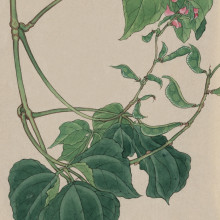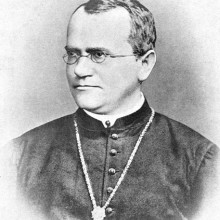Naked Genetics is back with new episodes every month! Today we're taking a step back. Where does genetics actually come from? How did we get to today's world of genome sequences and gene editing? It all started with a 19th-Century monk, working in his garden - but who was he really, and how did it take thirty years for him to be recognised? If you think you know this story, you might be surprised.
In this episode

01:39 - Pea flowers of purple and white
Pea flowers of purple and white
Xander Jones, University of Cambridge
What does the ‘genetics’ mean to you? Maybe you’re an expert - or maybe you’re a newbie; someone who’s heard of genes, and DNA testing, and genetic diseases, but someone who’s not sure how all the pieces fit together. So let’s fix that, by going back to where it all started. This is a trip through time to meet a German monk called Gregor Mendel, who kick-started a brand new type of science. Phil Sansom went out in the garden to speak to plant scientist Xander Jones...
Xander - So we're in the Cambridge University Botanic Garden. Right now we're looking at a pea flower much like the ones that Mendel would have been working with when he was studying the rules of inheritance.
Phil - They’d really look like that? Because this is like... would you call this a blossom? And it's covered in purple flowers?
Xander - Yeah. it wouldn't be exactly like this because this is not a common pea that he would have been working with, but the flower shape is just like he would have seen.
Phil - You’ve got these weirdly-shaped purple petals, one of which is hooked around from underneath, and you're pulling them open like insect parts. And inside there's all these yellow little protrusion... what looks like threads, with yellow parts on the end.
Xander - And next to the yellow parts is one white part, and that’s actually the female tip.
Phil - These are all tiny.
Xander - They're very small. So Mendel was a monk in a monastery in what's now the Czech Republic. And he was interested in the rules of inheritance. So it was known that if two parents had certain traits that the offspring were likely to have similar traits. But the going theory at the time was that the traits would simply blend. That's understandable, because many traits do work like that; we often think of height like this. But Mendel had figured out that some traits didn't work like that, and set out to study it in a more rigourous way. He originally wanted to work on mice I’ve heard, but then his superior thought that might be a little too untoward, to be controlling which mice were mating with which mice. So they settled on peas. Which I think was a smart choice.
Phil - How many of these did he have in his monastery garden?
Xander - Hundreds. Even thousands. He quantified many thousands of plants in terms of their traits. So he picked out seven traits that had this certain characteristic. So I'm showing you this flower here. Sometimes there’ll be a purple-flowered pea; sometimes when you bred a purple flower with a white flower, you got only purple flowers.
Phil - Weird.
Xander - Really weird. And even weirder is in the next generation, all of a sudden white flowers would reappear. So a trait was sort of hidden. And he thought there was something about that that was interesting and important, and he was right. And so what he figured out was that if he took these yellow parts, the male parts, and he removed them before it self-pollinated...
Phil - Oh no, you're picking apart the flower...
Xander - Yeah.
Phil - Oh boy, you’ve taken all the parts off.
Xander - Well that one I messed up. So that shows you how good he had to get at this delicate operation. So I’ll take another flower and I’ll remove the male parts. This is called emasculating. So now we have a flower that only has the female part, the stigma, waiting for it to be pollinated.
Phil - And Mendel did this with his hands thousands of times?
Xander - He may have had more sophisticated tools like tweezers.
Phil - But still he had to have this level of care...
Xander - Thousands and thousands of times.
Phil - That's incredible.
Xander - It's a labour of love, I’m sure.
Phil - It seems so simple but in theory what you've just done is crossbreed one flower with another, right?
Xander - Right, and if you knew the traits of the parents then you could track those traits into the next generations. So he didn't know anything about what the basis for those traits were, but he could see how the traits would come out in terms of the numbers in each generation. He had purple flowers that were true breeding and white flowers that were true breeding, he’d cross them, the next generation would be purple. After he selfed that generation, so the flowers that had the male parts and the female parts would do their own business, and then in the next generation he would see white flowers again - twenty-five percent of the time, on average - and seventy-five percent of the time he would see purple flowers.
Phil - You've got a purple-flower plant and a white-flower plant. You breed them. You get their kids.
Xander - They're all purple.
Phil - The kids are all purple. But the kids breed with themselves. And the grandkids you get, for every one white, you get three purple.
Xander - That's exactly right. Which isn't so much information, but he was able to surmise quite a lot from that. That 3:1, it means that there are two factors in the middle generation that are sorting out; either together, mixed, or separate.
Phil - Those are what we now call the two copies of each gene right?
Xander - Right.
Phil - Do you think for him in his garden with his thousands of pea plants, over and over again putting one into the other... what do you think was going through his mind?
Xander - Actually my hunch is that he knew he was on to something interesting and that he wanted to make a contribution. Just like all of us do!

The laws of inheritance
Greg Radick, University of Leeds
The story goes that Mendel was ahead of his time in some way - a visionary genius, unappreciated during his life. But if that’s true, then where does someone like that come from? Genius surely can’t spring from thin air. To learn more, Phil Sansom talked to historian Greg Radick...
Greg - Mendel was born in 1822. His parents were not-very-well-to-do farmers. And it quickly became apparent that Johann, as he was called, was very gifted intellectually - marked out to do something special. So in 1843 Mendel enters the monastery, and he went on to study at the University of Vienna. So we sometimes have this picture of Mendel as the monk in the garden; and that's deeply misleading, because he had about as good a scientific education as you could receive.
Phil - He goes back to the monastery with this fantastic training and decides he wants to undertake a study on plant hybrids, and what happens to traits like the colours of the flowers or the seeds.
Greg - And where Mendel went beyond his predecessors is that he spent two years making sure that for example, when he had a yellow-seeded pea, that its progeny only ever produced yellow-seeded peas; that is to say, it was ‘true breeding’. So purified his stocks, and then upon crossing he counted. And again this was a break with his predecessors. No-one had ever done this, certainly not at the scale that Mendel did.
Phil - So this was one of his smart moves: taking these ideas about rigour from the physical sciences he learnt at the University of Vienna, and for the first time applying them to plant breeding. He kept records. He repeated experiments. He used controls.
Greg - He carried on these studies for about eight years, and in 1865 he gave a couple of lectures to the Brünn Natural Sciences Society about what he discovered. Brünn itself is something like the Leeds or Manchester of Central Europe, it's an industrial powerhouse. Mendel’s in this fantastic environment...
Phil - And his results are really well received. The crux is this pattern that Xander was talking about, that when you cross a true-breeding plant with yellow peas to one with green peas, the kids are all yellow, and the grandkids are - on average - three yellow to one green.
Greg - And he called the yellow character the dominant character. By contrast the green character, which disappeared in that first generation but then reappeared, he called the recessive character. So Mendel finds this new pattern. But he goes on then to explain it.
Phil - His theory is that when reproducing, a plant could only pass on either greenness or yellowness, but never a mixture of the two. What we now call his Law of Segregation. In his paper he followed through the maths, the probabilities of what would happen if his theory was true. And the maths showed exactly what his experiments found. A 3:1 ratio of yellow to green.
Greg - So a new pattern is discovered and the new explanation is offered.
Phil - He even extends his theory to more complex ideas. What if you have two traits you’re dealing with? Three? Well, he found each trait is inherited independently of what’s going on with the others. What we now call his Law of Independent Assortment.
Greg - So it’s altogether quite an amazing paper. And then Mendel is elected abbot of his monastery. At that point his scientific studies more or less come to an end and he gets used up in administration. Which seems like a tragedy for science, but as far as we can tell for Mendel it seemed to have been quite a good move. He always had health problems, nervous breakdowns we would call them now, from time to time; all of that seems to go away when he becomes abbot. And he dies in 1884, a respected member of the community, and not especially well known. But then in 1900, quite suddenly, he goes from being pretty obscure to being someone that a lot of people are talking about.

The birth of genetics
Helen Curry, University of Cambridge
Everything changes at the turn of the 20th Century. This is when biologist William Bateson first coins the word “genetics”, the start of what becomes a whole new discipline of science. If Gregor Mendel really is the father of modern genetics, then around 1900 is when it was finally born - overdue by three decades. It’s a confusing time, filled with hype about this new experimental biology. Here in Cambridge where Naked Genetics is based, this was one place where that hype translated into cold, hard funding. Helen Curry is a historian of genetics here, and she took Phil Sansom out onto the streets to show him something...
Phil - You’ve brought me out here to 44 Storey’s Way. Why are we here?
Helen - 44 Storey’s Way is the site of the first Department of Genetics at the University of Cambridge. And I think it's a really important place for stopping to think about what genetics was in the early part of the twentieth century. Because the reason the Department of Genetics was sited here was so that it could be nearby to the university’s farm site.
Phil - So genetics when it was first starting out was really, really tied to agriculture?
Helen - Yeah, that's absolutely right. A lot of the early enthusiasm for Mendelian ideas, Mendelian laws, had to do with the fact that it promised a more scientific, more predictable approach to creating new kinds of crops and new kinds of agricultural animals.
Around 1900 there were two different contexts that were operating in related ways but distinct from one another. One was an area of experimental evolution. And then there was also a world of crop development. And what happened in 1900 was that three different researchers independently claim to have come across the work of Gregor Mendel: Hugo de Vries, a Dutch botanist; Carl Correns, who was a German botanist; and Erich von Tschermak, an Austrian agronomist.
Phil - Think about that. Three people independently discovered - or rediscovered - these principles of inheritance at the same time. Who should take the credit? Maybe the easiest thing is to point to a dead monk who’d already done the work, and give him credit instead. No more conflict. Mendel becomes a legend. In any case, it’s biologist William Bateson in Cambridge who becomes the real champion of this work. Bateson coins the word “genetics” and he starts spreading the good news of Gregor Mendel far and wide.
Helen - By 1912 he'd managed to convince enough people in Britain that resources were put forward to establish the first ever chair in genetics...
Phil - And why agriculture? Why was that the big thing that people were using this for?
Helen - At the end of the nineteenth century when these changes in biological understanding were happening, there were also significant changes going on in agriculture. So the establishment of institutions, state institutions governing agricultural production, also governing agricultural research; rising industrialisation; you have changes in mechanisation and farming; there's a whole lot of interest in making farming better.
Phil - Why?
Helen - In order to feed people. To feed armies. To drive economic growth.

15:60 - Eugenic agenda
Eugenic agenda
Helen Curry, University of Cambridge
We’re talking about the father of modern genetics, Gregor Mendel. When he was posthumously rediscovered around 1900, scientists were excited to put his laws to use - feeding millions by breeding the crops of tomorrow, and understanding this tricky thing called evolution. But that’s not all they wanted to use it for - and be warned, some of these next ideas are a little darker. Phil Sansom is talking with historian Helen Curry...
Phil - What about eugenics? What was going on there?
Helen - Eugenics is an extremely important context for also understanding what was going on around 1900. In the preceding decades, here in Britain you'd had Francis Galton put forward ideas about the inheritance of degenerate characteristics, and the overall decline of the population, and an idea that there should be controlled breeding of humans. Mendelian genetics, just as it created these frameworks for understanding plant and animal improvement, also facilitated a set of ideas about what was needed to be accomplished for human improvement.
If the underlying mechanisms of heredity were known to be the same across all living things, well, it shouldn’t be surprising that we would see people picking up these ideas and applying them similarly. I think what is sometimes surprising is how vigorously the eugenic agenda was adopted. Looking back it in some cases seems unbelievable, because the traits that people were interested in were things like feeble-mindedness which was basically a catch-all category for anything that people thought was an undesirable characteristic, and as you might imagine was much more associated with class and race than it was with any sort of recognisable, consistent characteristic.
Phil - This eugenic agenda persisted well into the 60s in the US, with the last of the sterilisation laws. It’s a nasty - and wrong - application of a science that became ubiquitous. And all of it built on the shoulders of the unsuspecting Gregor.

18:30 - Variable hybrids: "exceptionally classy work"
Variable hybrids: "exceptionally classy work"
Greg Radick, University of Leeds
There’s an anecdote from a New Orleans flower dealer who visits Mendel and asks to see the work he’s doing with his peas. Mendel obliges, and when asked how it works, says, “it is just a little trick, but there is a long story connected with it which it would take too long to tell.” What did he mean? Is that story the same story we tell about him today? Historian Greg Radick had a great answer for Phil Sansom.
Greg - The question arises: what exactly was Mendel trying to do with his paper? A traditional way of looking at this question is to think of Mendel as basically trying to found what we call the science of genetics, to establish a new way of investigating heredity. Nothing like that was the case. He was interested in understanding hybrids.
There were two kinds of hybrids. One was the kind where when you crossed Variety A and Variety B, you got a hybrid with an interesting character, let's call it C. And then when you let C self-fertilise, that interesting hybrid character stuck - it remained constant. Then there was the other kind of hybrid, where you crossed A and B, you got C, then when you let C self-fertilise, the hybrid character broke up and you got other things. We could call those variable hybrids. So two kinds of hybrids as far as Mendel is concerned: the constant ones and the variable ones.
In the famous paper he is interested in variable hybrids. His question is: is there a law that governs the characters that appear after the hybrid generations, and if there is a law, what is that law? And if you take seriously Mendel’s own way of understanding what he was doing, I think it throws some light on this pseudo-question of why it is that it took 34, 35 years for anybody to notice. In Mendel’s own eyes, as in the eyes of his contemporaries, he had done exceptionally classy work - and I mean really classy, mathematically classy, explanatorily classy - within a restricted domain: the scientific understanding of plant hybrids, the variable hybrids.
Phil - Some people say “Mendel was not a Mendelian”, and this is what they mean - he himself wasn’t bothered with looking at heredity. If you look at history like this, the thing that changes over thirty years isn’t that science gets up to his level; it’s just that studying hybridisation goes from being an end in and of itself, to a means to investigate heredity and evolution.

20:51 - A genome in forty hours
A genome in forty hours
Ursula Arndt, illumina
Today, genetics has reached heights Mendel could barely have dreamed of. Phil Sansom visited top gene sequencing company Illumina to speak to one of their researchers, Ursula Arndt. She showed Phil round one of their labs.
Phil - What’s this one?
Ursula - So this is a NextSeq. Your NextSeq can do one whole human genome in under forty hours. Which is pretty impressive
Phil - How long did they take to do the first one ever?
Ursula - Thirteen years? Right? So the first one, thirteen years, something like three billion dollars; and this one, less than forty hours and you have your whole human genome.
Phil - How is that possible?
Ursula - Honestly it's just a lot more time has gone into research, into development. NovaSeq could do 24 human genomes in one run, in forty hours.
Phil - Here’s how you use one of these incredible machines. You take a sample, smash it up, and separate out the DNA. You tag it so you know where each bit is, and you put it on a flow cell - a black tile that looks like a futuristic hard drive. Then you put it in the sequencer, it illuminates one DNA base at a time, and the computer records the sequence. Finally, the computer calculates how all the individual bits should fit back together, and voilà - the whole gene sequence is right there.
Gregor Mendel had to spend eight years carefully cross-breeding peas. Imagine what he would say if he saw how you could learn every single gene in a pea in forty hours.
Ursula - He would have had his mind blown. We are still impressed. I'm still impressed every time I think about the technology and the technological advances, and just seeing how far we've come in the past ten to fifteen years. If you look at what he did, he did fifteen plants at a time and then he had to wait for the next generation. And now within a week you could have the full dataset of those fifteen samples, and could be sitting on your computer and analysing and comparing them.

22:41 - Gins & Genes: Oh, you're a mutant!
Gins & Genes: Oh, you're a mutant!
Alexis Braun & Eva Higginbotham, University of Cambridge; Patrick Short, Sano Genetics
It’s time for Gins & Genes - a brand new segment hosted by the Cambridge Distillery. Phil Sansom assembled three genetics experts to sample some gin and ask them some of the burning questions that are left over from the episode. This week’s panel is Alexis Braun, Eva Higginbotham, and Patrick Short…
Patrick - Hi, I'm Patrick, I'm a researcher in rare diseases and CEO of a startup company called Sano Genetics.
Alexis - Hi, I'm Alexis, I'm a postdoctoral researcher in the Department of Genetics with the University of Cambridge.
Eva - I'm Eva and I'm a PhD student at the Department of Zoology in Cambridge.
Phil - So welcome to the first ever Gins & Genes here at the Cambridge Distillery. Will Lowe who runs the distillery is here to tell us: what gin are we going to try?
Will - Well we're gonna start off with Cambridge Dry Gin. It’s the flagship of Cambridge Distillery. We have a unique method of distillation which means we take each botanical individually and we distil them at different temperatures to preserve the freshness. So everything that's in this gin, the recipe, originally was actually grown in my own back garden.
Phil - Cheers everyone.
In this episode we've been talking about Gregor Mendel, right. Gregor Mendel spent eight years rubbing bits of flowers onto each other. Is that at all similar to the way genetics looks today?
Alexis - We do in a way do similar things. We will pick a specific animal, mate it to another one, probably have to go through lots of different crossing just to try and get to a point where we can answer our questions.
Eva - Thinking about it, the life of someone who works with flies is so similar to those eight years of Mendel rubbing together bits of plants. I mean, we spend a lot of time moving flies around on these little plates that are infused with carbon dioxide so they fall asleep and don't just fly away. And you move them around with a paintbrush, and you sort them, and so you collect the flies you want to then mate with other flies, and it's a lot of choosing the right ones to mate with the other ones. It's just having it put in that way I find...
Phil - Is it reductionist?
Eva - No, it really resonates actually. Just because the life of a geneticist can look like, I'm doing really fancy science, I’m going to use a fancy machine, I'm going to extract some DNA, I’m going to extract some of this and that. But also the life of a geneticist is looking at flies under a microscope and choosing the best boy and the best girl, and putting them together in a tube.
Phil - Some people say that when it comes to the way that genetics gets taught... it always starts with Mendel, but some people say that teaching should, I don't know, be revamped - because we know so much now about the way your environment changes you. What do you guys think?
Alexis - I strongly disagree. You have to start with the basics, and it can expand into more complicated things. But I think you would never start with calculus; you would teach basic arithmetic first.
Patrick - To your point though, I would say, sometimes it takes us a long time to unlearn these things. I worked on rare disorders in my PhD which are often described as Mendelian, which means it's caused by a single gene, or a single mutation in a single gene, or two inherited variants. The thing that we're relearning now is that actually, even in some of the most clear-cut Mendelian cases where you have a single gene that's hit, it's modified by your environment, it's modified by other genetic variants. And there are also cases where people have the mutation that you'd suspect would cause a disease, but they don't have it.
So there's clearly other things going on. And sometimes it takes us as scientists a long time to unlearn the many decades of, “this is how things work,” and then you have to occasionally revise your thinking to incorporate new knowledge. But I would still say I agree that if you start with, “it's really complicated, genetics, environment, it can be every gene, it can be one gene,” then the kids are going to probably just say, “I'm out of here and I'll be watching YouTube instead.”
Eva - Generally I agree that we want to start kids off in a way that seems relatable and understandable when it comes to genetics, and hype up the interest. And one way teachers try and do that often is to try and find specific things about the student.
So for example everyone's heard of the eye color. You know, brown eyes are dominant over blue, green are a bit weird. And I actually have, one of my eyes is half brown. And I remember being in Year Seven in science and we learnt that brown eyes are dominant, blah blah blah. And I said to the teacher, “what about me, one of my eyes is half brown?” And she said, “oh, you're a mutant!” And I quite liked that because I liked science, that was fine with me. But at the same time it's also really hugely inaccurate.
So I think what Patrick’s saying about “takes time to unlearn things” is really valid. And actually I was looking through some myths of human genetics. So the one that really surprised me is that apparently some kids were taught that the direction that you cross your arms is dependent on your genetics. If you just cross your arms now, you guys. Okay, so Patrick has his right arm on top. Alexis, oh, she has her left arm on top. Now some kids were taught that if you put your right arm on top that's a dominant trait, but if you put your left arm on top that's a recessive trait. Which is just... it's just incredibly wrong! I mean, that kind of... it's unbelievably wrong. I was just so amazed.
But it turns out that there is one really great example of something that really does follow the rules of Mendelian inheritance, and that is earwax. I know, I know, it's gross. And there are actually two types. And which type you have is really largely dependent on which geographical part of the world your ancestors came from.
So if you’re ancestrally from parts of Europe or from Africa, or a few other places, then you likely have wet earwax, which means that it ranges from yellow to brown and it's wet. Now if you are from most of Asia - in particular Southern Asia - then it's likely that you have dry earwax, which means that it's sort of grayish in color and crumbly. I'd never heard of this before I saw this example.
And it's actually really true that it's dependent on one base pair change, from a G to an A. And if you have a G you make wet and if you have an A you make dry. So in some ways that's kind of like the best... it's a pure example that you could use to teach children - if you wanted them to be playing with earwax in the classroom - about this Mendelian inheritance.
But I do think it's true that we need to be careful that we don't go around telling kids, “oh, how you cross your arms, what color your eyes are, whether your earlobes are attached, whether you have a widow's peak, whether you have a hair whorl…” I mean the list is amazing, and that should probably be... we should pull back on that I think.










Comments
Add a comment